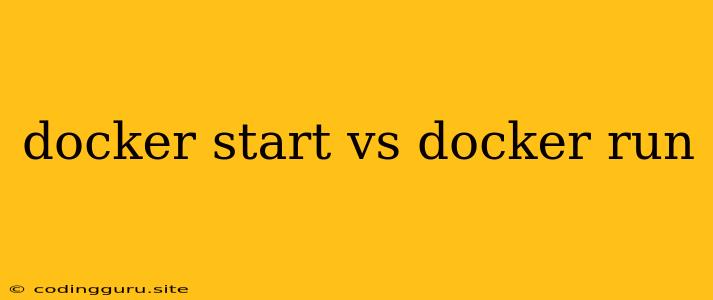Understanding the Difference Between docker start and docker run
When working with Docker, you'll often encounter the commands docker start and docker run. While both commands deal with starting containers, they have distinct purposes and use cases. This guide aims to clarify the differences between these two commands, helping you choose the appropriate command for your needs.
What is docker run?
docker run is the command used to create and start a new container. It takes an image as input and uses that image to build a container, allocating resources and assigning an IP address.
Example:
docker run -d -p 80:80 nginx
This command pulls the nginx image, creates a new container based on it, runs the container in the background (-d), maps port 80 of the host machine to port 80 of the container (-p 80:80), and starts the Nginx server within the container.
What is docker start?
docker start is used to resume a stopped container. It doesn't create a new container; it simply starts an existing container that was previously stopped.
Example:
docker start
This command will start the container with the specified container_id.
Key Differences:
Here's a table highlighting the key differences between docker run and docker start:
| Feature | docker run |
docker start |
|---|---|---|
| Purpose | Creates and starts a new container | Resumes a stopped container |
| Container State | New container | Existing container |
| Image Required | Yes | No (Uses existing container's image) |
| Resource Allocation | Allocates resources and assigns IP address | Reuses existing resource allocation |
| Data Persistence | No (unless specified with volumes) | Preserves data from previous state |
| Port Mapping | Can map ports | Reuses existing port mappings |
When to Use docker run vs. docker start:
-
Use
docker runwhen:- You want to create a new container from an image.
- You need to set up a new container with specific configurations like port mappings, volumes, etc.
- You are starting a container for the first time.
-
Use
docker startwhen:- You want to restart a previously stopped container.
- You need to quickly resume an existing container without re-creating it.
- You want to preserve the container's data and state.
Example Scenario:
Imagine you have a web application containerized with Docker.
- First time running the application: You'll use
docker runto create and start the container. - Stopping the application: You can stop the container using
docker stop. - Later, restarting the application: You'll use
docker startto resume the stopped container.
Benefits of using docker start:
- Faster Startup: Starting a container with
docker startis often faster than runningdocker runsince it doesn't require creating a new container or allocating resources. - Data Preservation: Data stored within the container is preserved when using
docker start, as the container retains its state from the previous run. - Resource Efficiency:
docker startavoids unnecessary resource allocation and image pulling, leading to more efficient resource utilization.
Conclusion:
docker run and docker start are essential commands in the Docker ecosystem, serving distinct purposes. Understanding when to use each command is crucial for efficient Docker management. By using docker run for creating new containers and docker start for restarting existing containers, you can streamline your Docker workflow and optimize resource utilization.
